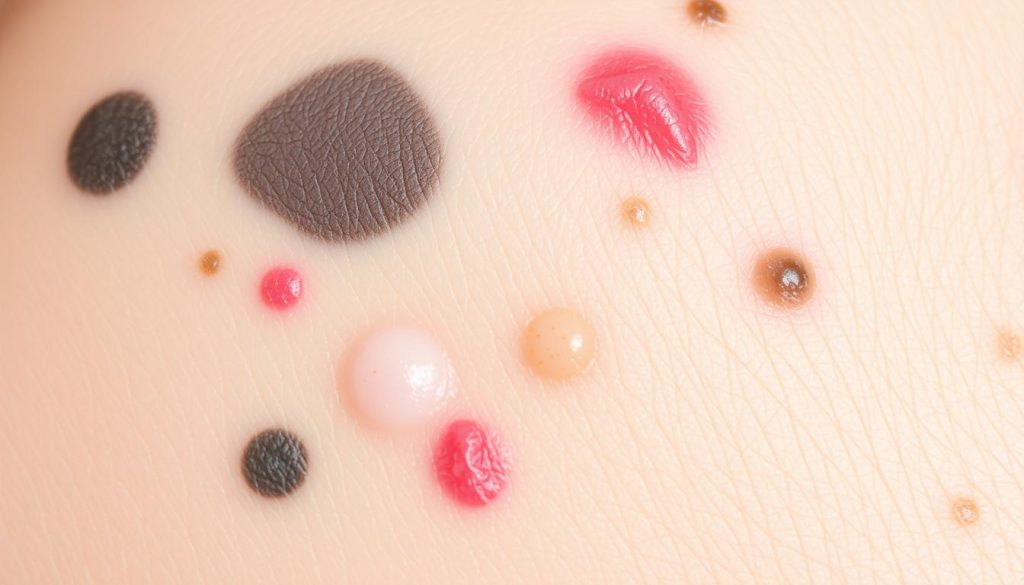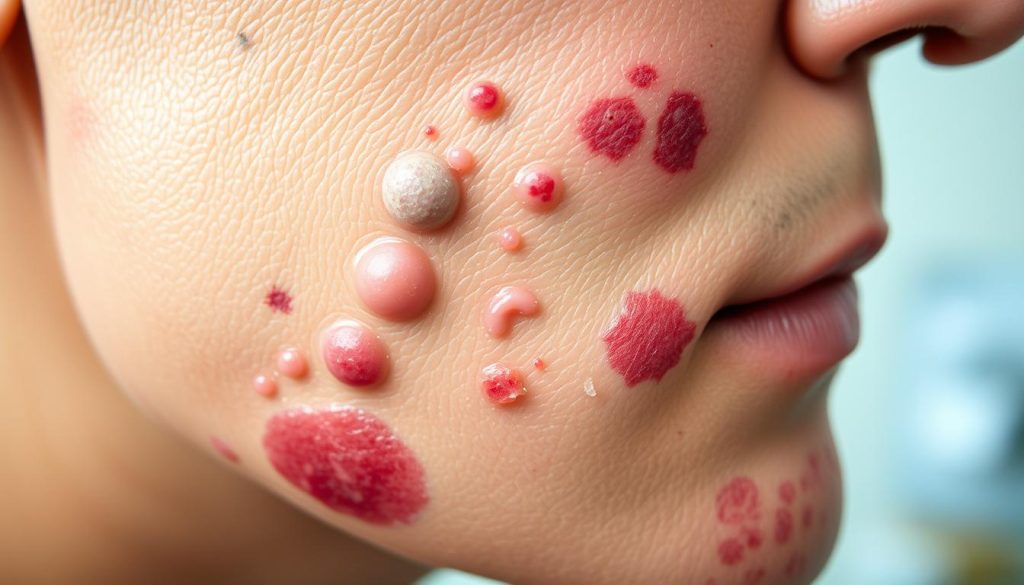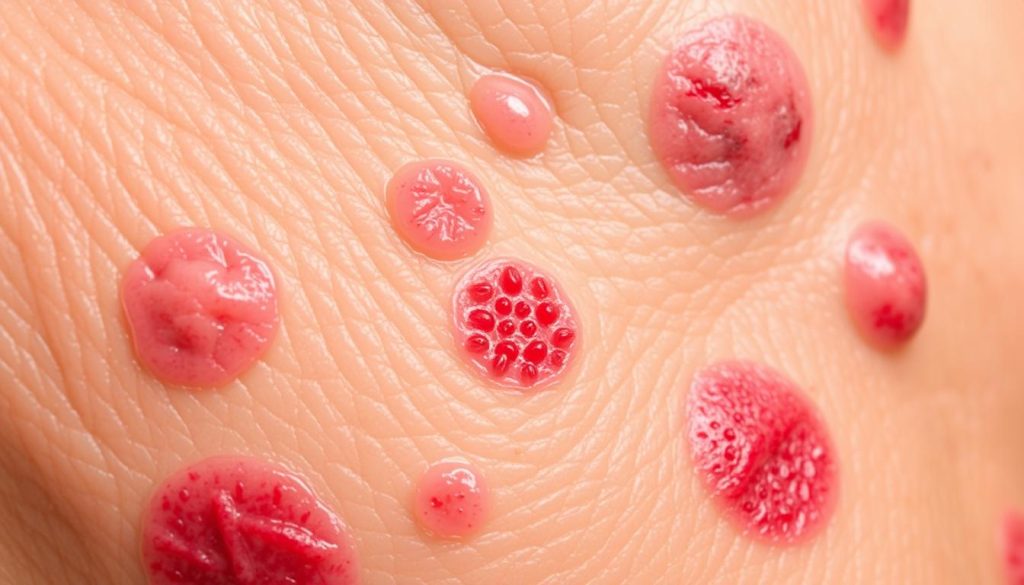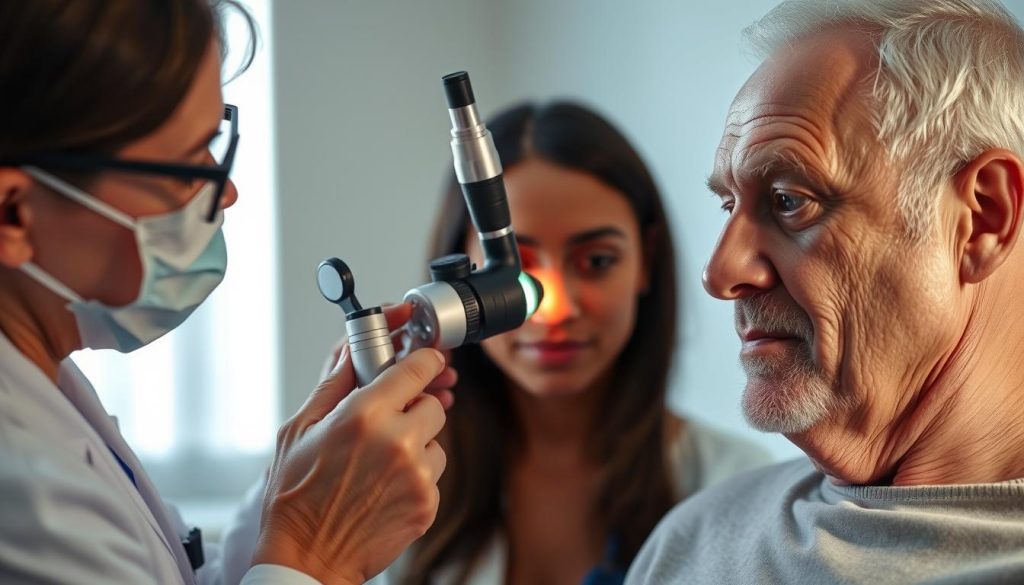Skin cancer pictures are key to spotting problems early. They show different types of skin cancer and their signs. Knowing these images helps you see skin cancer symptoms early on.
Spotting skin cancer early is vital for treatment success. Pictures of skin cancer are useful for doctors and patients alike. They point out small changes in moles or skin color that might be missed.
Learning to recognize these signs helps you take care of your skin. Regular self-exams and knowledge from pictures can catch issues early. If you’re unsure, always see a doctor for a check-up.
Understanding Different Types of Skin Cancer Through Visual Documentation
Diagnosing skin cancer often begins with looking at it. Knowing what each type looks like can lead to early detection. Let’s look at the main types of skin cancer through photos of skin lesions.
Basal Cell Carcinoma Characteristics
Basal cell carcinoma looks like shiny, pearly bumps or flat, scarlike spots. These spots might bleed or crust over. They usually show up on sun-exposed areas like the face and neck.
Squamous Cell Carcinoma Identifiers
Squamous cell carcinoma looks like firm, red bumps or flat spots with a scaly, crusty top. They can appear anywhere but are more common in sun-exposed areas.
Melanoma Visual Markers
Melanoma images show moles or growths with irregular shapes, uneven colors, and asymmetry. They can change over time, growing or changing color.
| Type | Appearance | Common Locations |
|---|---|---|
| Basal Cell Carcinoma | Shiny bumps or flat, scarlike lesions | Face, ears, neck |
| Squamous Cell Carcinoma | Firm, red nodules or scaly, flat lesions | Face, ears, hands, arms |
| Melanoma | Irregular moles or dark spots | Any body part, including hidden areas |
Knowing these visual signs is key for early skin cancer detection. Regular self-checks and doctor visits can spot suspicious spots early.
The ABCDE Rule in Skin Cancer Pictures
Skin cancer symptoms can be hard to spot. But the ABCDE rule makes it easier. This guide is key for looking at mole pictures and spotting melanoma images. Let’s explore each letter of this important acronym.
A stands for Asymmetry. Healthy moles are symmetrical. If you draw a line through the middle, both sides should look the same. If a mole is not symmetrical, it might be a sign of trouble.
B is for Border. Normal moles have smooth borders. If a mole’s border is jagged or blurry, it’s a warning sign.
C represents Color. Most moles are one color. If a mole has many colors or looks blue, white, or red, it’s a concern.
D denotes Diameter. Most harmless moles are small, about the size of a pencil eraser. If a mole is bigger, it could be melanoma.
E means Evolving. Any changes in a mole’s size, shape, or color are serious. Keep an eye on your skin’s changes over time.
| ABCDE Criteria | Normal Mole | Suspicious Mole |
|---|---|---|
| Asymmetry | Symmetrical | Irregular shape |
| Border | Smooth edges | Jagged or blurred |
| Color | Uniform | Multiple shades |
| Diameter | Less than 6mm | Larger than 6mm |
| Evolving | Stable appearance | Changes over time |
Regular self-exams with the ABCDE rule and doctor visits are vital for early detection. If you see any worrying changes, see a dermatologist right away.
Common Locations Where Skin Cancer Typically Develops
Skin cancer can show up anywhere on the body. But some spots are more likely to get cancerous lesions. Knowing these areas is key for catching skin cancer early. This helps with diagnosis and treatment. Let’s look at where skin cancer often appears.
Face and Neck Manifestations
The face and neck get a lot of sun, making them high-risk for skin cancer. Photos often show cancer on the nose, cheeks, and forehead. Look for rough patches or pearly bumps that don’t heal.
Trunk and Back Appearances
Skin cancer on the trunk and back can be hard to find without checking yourself often. Watch for new moles or changes in old ones. Back melanomas are often missed until they’re big, so it’s important to have someone else check you.
Extremities and Hidden Areas
Don’t forget about arms, legs, and hidden spots like between toes or under nails. Skin cancer pictures reveal growths or streaks in these areas. Getting a full-body skin check is key to finding these cancers early.
| Body Area | Common Skin Cancer Types | Key Visual Indicators |
|---|---|---|
| Face and Neck | Basal Cell Carcinoma, Squamous Cell Carcinoma | Pearly bumps, scaly patches |
| Trunk and Back | Melanoma | Irregular moles, dark spots |
| Extremities | All types | Sores that don’t heal, pigmented streaks |
Skin Cancer Pictures: A Visual Guide to Detection
Skin cancer pictures are key to learning about this disease. They help you spot signs of skin cancer on your body.

Melanoma images show dark, odd-shaped moles that change. These pictures teach us the ABCDE rule for spotting melanoma:
- Asymmetry
- Border irregularity
- Color variations
- Diameter larger than 6mm
- Evolving size, shape, or color
Non-melanoma skin cancers, like basal cell carcinoma, look like pearly, flesh-colored bumps or pinkish patches. Squamous cell carcinoma images show scaly red patches, open sores, or wart-like growths.
Skin cancer symptoms can look very different. Some may be persistent sores, while others seem like normal moles. That’s why it’s important to get regular skin checks and see a doctor early.
| Type of Skin Cancer | Common Visual Characteristics |
|---|---|
| Melanoma | Dark, irregularly shaped moles; multiple colors |
| Basal Cell Carcinoma | Pearly bumps; pinkish patches; scar-like areas |
| Squamous Cell Carcinoma | Scaly red patches; open sores; wart-like growths |
Looking at these pictures can make you more aware of warning signs. If you see anything odd on your skin, see a dermatologist right away.
Normal vs. Suspicious Moles: Photo Comparison
It’s vital to know the difference between normal moles and ones that might be cancerous. Looking at mole pictures can help you spot problems. But, it’s important to know what to look for.
Healthy Mole Characteristics
Normal moles have certain traits. They are usually round or oval and have smooth edges. Their color is even, and they don’t change over time. They are also small, like a pencil eraser.
Warning Signs in Mole Appearance
Suspicious moles show signs that need attention. These include irregular shapes, uneven edges, or different colors in one mole. Skin lesion photos often show these warning signs:
- Asymmetry: One half doesn’t match the other
- Border irregularity: Edges are ragged or blurred
- Color changes: Multiple shades within one mole
- Diameter: Larger than 6mm (about 1/4 inch)
- Evolution: Changes in size, shape, or color over time
| Feature | Normal Mole | Suspicious Mole |
|---|---|---|
| Shape | Round or oval | Irregular or asymmetrical |
| Border | Smooth, well-defined | Jagged or blurred |
| Color | Even tone | Multiple colors or changes |
| Size | Usually under 6mm | Often larger than 6mm |
| Changes | Stable appearance | Evolving over time |
If you see any of these signs, get a professional skin cancer check. Regular self-checks with mole pictures can help you notice changes early.
Early Warning Signs Captured in Clinical Photography
Clinical photography is key in spotting skin cancer early. These high-quality images show small changes that might miss the eye during self-checks. Doctors use these photos to watch for problems over time.

Dermatologists use detailed photos to find early signs of skin cancer. These images show changes in size, shape, or color of moles and lesions. By comparing photos, doctors can spot issues fast.
Some important signs seen in these photos include:
- Asymmetry in mole shape
- Irregular or jagged borders
- Variations in color within a single spot
- Growth or changes in size over time
- New moles or lesions appearing suddenly
Using professional photography for skin cancer diagnosis helps catch it early. This method helps doctors assess skin changes accurately. It can save lives by starting treatment early.
How Skin Cancer Progresses: Visual Timeline
It’s important to know how skin cancer grows to catch it early. Pictures and images of skin cancer and melanoma help us see the different stages. Let’s look at how skin cancer moves from the beginning to more serious stages.
Initial Appearance Changes
In the early stages, skin cancer might look like small, harmless spots. Basal cell carcinomas can appear as pearly bumps or pink patches. Squamous cell carcinomas might look like scaly red patches or open sores.
Melanomas often start as unusual moles or dark spots on the skin.
Mid-Stage Development
As skin cancer grows, the spots get bigger and change. Basal cell carcinomas may have a central depression or bleed easily. Squamous cell carcinomas can become crusty or ulcerated.
Melanomas often show signs like Asymmetry, Border irregularity, Color changes, Diameter increase, and Evolution of the mole.
Advanced Stage Indicators
In advanced stages, skin cancers can grow large and invade deeper. They may cause a lot of tissue damage, ulceration, or bleeding. Melanomas can spread to other parts of the body, making treatment harder.
Early detection through regular skin checks and quick medical attention is key to stopping it from getting worse.
| Stage | Basal Cell Carcinoma | Squamous Cell Carcinoma | Melanoma |
|---|---|---|---|
| Early | Pearly bump or pink patch | Scaly red patch or open sore | Unusual mole or dark spot |
| Mid | Central depression, easy bleeding | Crusty or ulcerated lesion | ABCDE signs evident |
| Advanced | Large, invasive growth | Significant tissue damage | Spread to other body parts |
Non-Melanoma Skin Cancer Visual Indicators
Non-melanoma skin cancers are the most common types of skin cancer. Knowing their visual signs is key for early detection. Let’s look at the main signs of basal cell carcinoma (BCC) and squamous cell carcinoma (SCC), two common non-melanoma skin cancers.

- A pearly, waxy bump
- A flat, flesh-colored or brown scar-like lesion
- A bleeding or scabbing sore that heals and returns
Squamous cell carcinoma usually looks like:
- A firm, red nodule
- A flat lesion with a scaly, crusted surface
- A new growth on an existing mole or scar
Skin lesion photos are very important for spotting these cancers. Regular self-exams and doctor visits can catch them early, leading to better treatment results.
| Feature | Basal Cell Carcinoma | Squamous Cell Carcinoma |
|---|---|---|
| Color | Pink, red, or flesh-colored | Red, pink, or brown |
| Texture | Smooth, pearly, or waxy | Rough, scaly, or crusty |
| Shape | Raised bump or flat patch | Firm nodule or flat lesion |
| Common locations | Face, ears, neck | Face, ears, hands, arms |
While these signs can help, a doctor’s diagnosis is needed for sure identification and treatment of any suspicious skin changes.
Rare Forms of Skin Cancer and Their Appearances
While common skin cancers are well-known, rare ones can be tricky to spot. It’s key to know about these uncommon types for early detection and treatment. Let’s look at two rare skin cancers and their unique looks.
Merkel Cell Carcinoma Images
Merkel cell carcinoma is a fast-growing skin cancer. It shows up as a firm, painless bump on sun-exposed areas. These bumps are usually red or purple and grow fast.
Skin cancer pictures of Merkel cell carcinoma show lesions that can look like other skin issues. This makes getting a professional skin cancer diagnosis very important.
Kaposi Sarcoma Visual Signs
Kaposi sarcoma is a rare cancer that grows in blood vessels and lymph nodes. It shows up as purple, red, or brown spots or tumors on the skin. These spots can be flat or raised and often appear on the legs, feet, or face.
Skin cancer pictures of Kaposi sarcoma show its unique purple color. This makes it stand out from other skin cancers.
Spotting these rare skin cancers early is critical. If you see unusual skin changes, get medical help right away. Doctors use many tools and methods for accurate diagnosis. This ensures the right treatment for even the rarest skin cancers.
Using Technology to Document Skin Changes
Modern technology has changed how we detect and monitor skin cancer. Now, smartphone apps help track mole pictures over time. This aids in catching problems early. These apps use AI to analyze photos and suggest when to see a doctor.
High-tech imaging has also improved a lot. Dermatologists use high-resolution dermoscopy to take detailed photos of skin lesions. This lets them see things that are not visible to the naked eye. It makes diagnosing skin cancer more accurate by giving a closer look at moles.
AI tools are becoming big helpers in dermatology clinics. They can quickly look through lots of skin cancer images. This helps doctors spot issues faster and more accurately. But, AI is not a full replacement for a doctor’s expertise.
Even with all these tech advances, it’s key to remember they’re just a help. Regular visits to a dermatologist are vital for preventing and catching skin cancer early.
Risk Factors and Their Visual Manifestations
Knowing the risk factors for skin cancer is key to preventing it. Visible signs can show if you’re at higher risk. This makes it easier to catch skin cancer early.
Sun Damage Indicators
Too much sun can leave marks on your skin. These signs often show before skin cancer does:
- Sunspots or age spots
- Wrinkles and leathery texture
- Broken blood vessels on the face
- Uneven skin tone
Getting your skin checked regularly is important. If you see any odd spots or growths, see a dermatologist. They can give a detailed skin cancer diagnosis.
Genetic Predisposition Signs
Some people are more likely to get skin cancer because of their genes. Look out for these signs:
- Fair skin that burns easily
- Blonde or red hair
- Blue or green eyes
- Many moles or freckles
- Family history of skin cancer
If you have these traits, watch your skin closely. Use sunscreen every day, wear clothes that cover you, and stay out of the sun when it’s strongest. Getting your skin checked often is vital for catching skin cancer early if you’re at high risk.
Professional vs. Self-Assessment of Skin Lesions
When it comes to skin cancer diagnosis, both professional evaluations and self-checks are important. Dermatologists can spot signs of skin cancer that you might miss. But, doing regular self-exams helps you keep an eye on any changes in your skin.

Professional skin exams have big benefits. Dermatologists use special tools and their trained eyes to find issues you might not see. They can also take skin cancer pictures to track changes over time.
Self-assessments let you check your skin often between doctor visits. Knowing what your skin looks like normally helps you spot changes fast. Taking mole pictures regularly can help you see if anything has changed in size, shape, or color.
The best plan is to do both. Check your skin every month and see a dermatologist once a year. This way, you get the best of both worlds: regular checks and expert care.
| Professional Assessment | Self-Assessment |
|---|---|
| Specialized tools and expertise | Frequent monitoring |
| Comprehensive full-body exam | Familiarity with own skin |
| Professional documentation | Quick detection of changes |
Early detection is the key to treating skin cancer successfully. By doing both professional exams and self-checks, you increase your chances of catching problems early.
When to Seek Medical Attention Based on Visual Changes
It’s important to know when to see a doctor about skin changes. If you notice new or changing moles, spots, or lesions, make an appointment with a dermatologist. Look out for signs like asymmetry, irregular borders, color changes, or sizes bigger than 6mm.
Using skin lesion photos can help track changes. Take clear, well-lit pictures of any areas that worry you and compare them each month. If you see quick growth, bleeding, itching, or crusting, get medical help right away. These could be signs of skin cancer.
Early detection is key to treating skin cancer effectively. Make it a habit to check your skin regularly and seek a doctor’s opinion if you’re unsure. Your quick action in checking and addressing suspicious skin changes can save your life.
FAQ
Q: What are the most common types of skin cancer?
A: The most common skin cancers are basal cell carcinoma, squamous cell carcinoma, and melanoma. Each type has its own look. You can spot them by looking closely at skin cancer pictures.
Q: How can I use the ABCDE rule to identify possible melanoma?
A: The ABCDE rule helps spot melanomas. It stands for:
– Asymmetry: One half doesn’t match the other
– Border: Irregular, jagged, or scalloped edges
– Color: Varied shades of brown, black, or tan; sometimes red, white, or blue
– Diameter: Larger than 6mm (about the size of a pencil eraser)
– Evolving: Changes in size, shape, or color over time
Check your moles and skin lesions with this rule. See a dermatologist if you notice any changes.
Q: Where does skin cancer typically develop?
A: Skin cancer can appear anywhere on the body. But it’s most common in sun-exposed areas. These include the face, neck, ears, hands, arms, and for men, the chest and back. But don’t forget to check less visible spots too, like between toes, under nails, and on the scalp.
Q: How can I tell the difference between a normal mole and a suspicious lesion?
A: Normal moles are symmetrical, have smooth borders, uniform color, and don’t change. Suspicious lesions often show the ABCDE signs of melanoma. Also, any mole that itches, bleeds, or has a crusty surface needs a dermatologist’s check.
Q: What are the early warning signs of skin cancer?
A: Early signs include:
– New growths or changes in existing moles
– Sores that don’t heal
– Rough or scaly red patches
– Raised bumps or lumps
– Pale, waxy, or pearly bumps
– Dark lesions on palms, soles, fingertips, or mucous membranes
Always see a healthcare professional if you notice these changes.
Q: How often should I have a professional skin cancer screening?
A: How often you need a skin cancer screening depends on your risk. Most people should get a full-body skin exam by a dermatologist every year. But those with a history of skin cancer or high-risk factors might need more frequent checks. Talk to your healthcare provider for advice.
Q: Can smartphone apps accurately detect skin cancer?
A: Smartphone apps can help track skin changes. But they’re not a substitute for a doctor’s check. These apps can help spot concerns, but they might miss some cancers or give false positives. Always get a dermatologist’s opinion for a proper diagnosis.
Q: What are the risk factors for developing skin cancer?
A: Risk factors include:
– Too much sun exposure or tanning bed use
– Fair skin, light hair, and light eyes
– History of sunburns, specially in childhood
– Family history of skin cancer
– Weakened immune system
– Exposure to certain chemicals or radiation
– Many moles or atypical moles
Knowing your risk can help you prevent skin cancer and decide how often to get skin checks.
Q: How can I prevent skin cancer?
A: To lower your risk of skin cancer:
– Use broad-spectrum sunscreen (SPF 30 or higher) daily
– Seek shade, specially during peak sun hours (10 am to 4 pm)
– Wear protective clothing, like wide-brimmed hats and sunglasses
– Avoid tanning beds
– Do regular self-exams
– Get annual skin check-ups with a dermatologist
– Stay alert to any skin or mole changes
Q: What should I do if I find a suspicious spot on my skin?
A: If you find a suspicious spot, don’t panic. Take clear, well-lit photos of it. Then, make an appointment with a dermatologist right away. Early detection and treatment are key for all skin cancers.

















